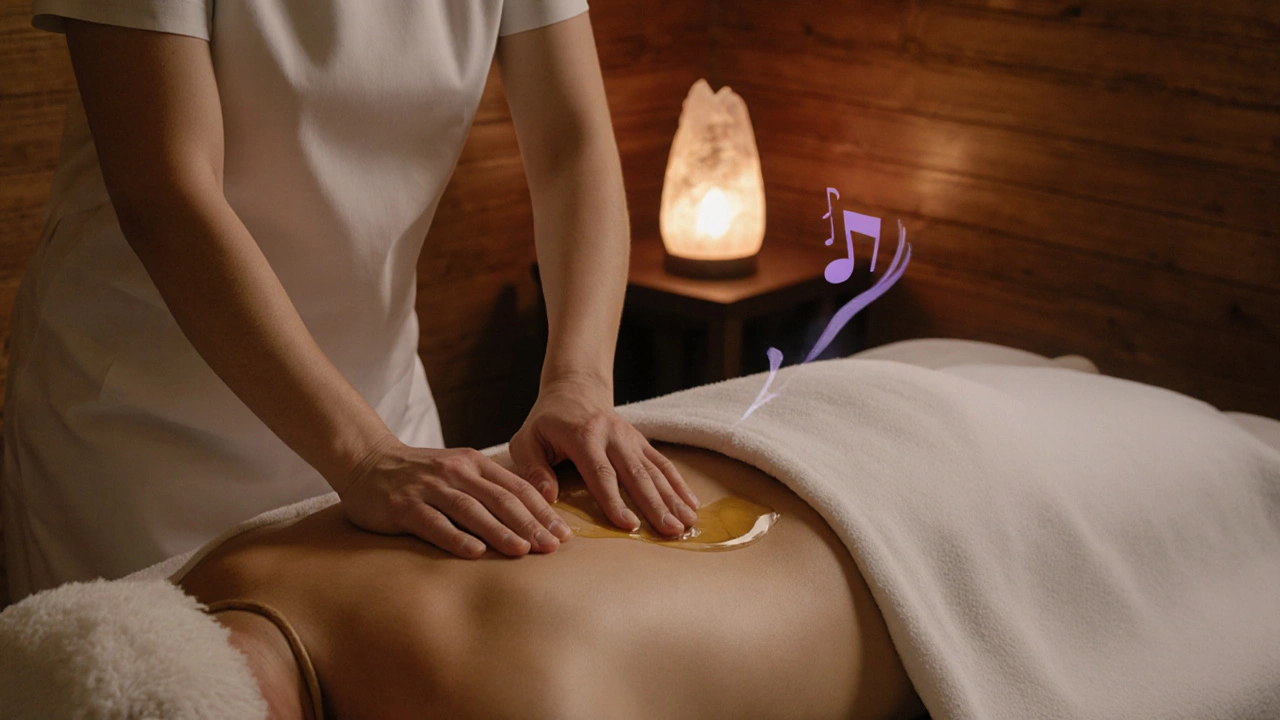The Do's and Don'ts of a Full Body Massage

You’ve booked your full body massage. You’re excited. Maybe even a little nervous. What should you actually do during the session? And what are the things you should absolutely avoid? Too many people walk into a massage room unsure, uncomfortable, or even embarrassed-and they leave without getting the full benefit. It doesn’t have to be that way.
What a Full Body Massage Really Is
A full body massage isn’t just a fancy spa treat. It’s a structured, therapeutic session that works on nearly every major muscle group-from your scalp down to your feet. Most sessions last between 60 and 90 minutes and combine techniques like kneading, long strokes, compression, and gentle stretching. It’s not about sexual touch, not about being naked the whole time, and definitely not about awkward small talk. It’s about letting your body reset.
Therapists use oils or lotions to reduce friction and help your muscles relax. The pressure can vary-from light and soothing to deep and firm-depending on what you ask for. A good therapist will check in with you. They’ll adjust based on your feedback. You’re not just a body on a table. You’re a person with needs.
Why It Matters
Stress doesn’t just live in your head. It settles into your shoulders, your lower back, your jaw. A full body massage helps release that tension. Studies show regular massage can lower cortisol (your stress hormone) by up to 30%. It improves circulation, reduces muscle soreness after workouts, and even helps with sleep quality.
Think about it: when was the last time you felt truly relaxed from head to toe? Not just mentally, but physically? That’s what this is for. It’s not a luxury. It’s maintenance-like changing your car’s oil, but for your body.
Do’s of a Full Body Massage
- Communicate your pressure preference-right away. If it’s too light, say so. If it’s too hard, speak up. Most people stay quiet because they don’t want to seem rude. But therapists expect this. They’re trained to adjust.
- Hydrate before and after. Massage moves toxins and fluids around in your body. Drinking water helps flush them out. You’ll feel less sore and more refreshed.
- Arrive 10-15 minutes early. Use that time to fill out forms, use the bathroom, and breathe. Rushing in means you’re still in ‘hustle mode’-and that defeats the whole point.
- Wear comfortable clothes to the studio. You don’t need to dress up. Sweatpants or a loose hoodie are perfect. You’ll change into a robe or towel anyway.
- Focus on your breath. Don’t try to ‘do’ anything. Just breathe slowly. In through your nose, out through your mouth. This helps your muscles let go faster.
Don’ts of a Full Body Massage
- Don’t eat a heavy meal right before. A full stomach makes lying on your back uncomfortable. It can also cause nausea, especially if deep pressure is used. Eat lightly 1-2 hours before.
- Don’t show up under the influence. Alcohol, marijuana, or other substances dull your sense of touch. You won’t be able to give accurate feedback. Worse-you might not notice if something feels wrong.
- Don’t try to ‘earn’ the massage. You don’t need to be ‘worthy’ of relaxation. You don’t need to have worked out hard or had a bad week. You deserve this just because you’re human.
- Don’t feel obligated to talk. Silence is golden. If the therapist starts a conversation, you can respond-but you’re not expected to. Many therapists work in near silence on purpose. Let them do their job.
- Don’t skip the post-massage cooldown. Don’t jump into your car and drive off. Sit for five minutes. Sip water. Let your nervous system settle. Rushing back into chaos cancels out half the benefits.

What to Expect During the Session
You’ll walk into a quiet room with soft lighting. Maybe there’s a little salt lamp, some calming music, or the scent of lavender. You’ll be given a robe and asked to undress to your comfort level. Most people keep their underwear on. Some wear shorts. Others go fully nude under the towel. It’s your call. The therapist will leave the room while you get settled.
They’ll knock before coming back in. Then they’ll explain the process briefly. You’ll lie on a heated table, covered with a sheet. Only the part being worked on will be uncovered. They’ll use draping techniques to keep you warm and private at all times.
The massage usually starts with your back, then moves to your legs, arms, neck, and finally your feet. Each area gets 5-10 minutes. You might feel some tenderness in tight spots-that’s normal. But sharp pain? That’s not. Tell them.
At the end, they’ll leave again so you can get dressed. You’ll be offered water. Then you’re free to go. You might feel a little lightheaded. That’s okay. Sit. Breathe. You’re not in a rush anymore.
Pricing and Booking
Prices vary by location, therapist experience, and session length. In most cities, a 60-minute full body massage costs between $70 and $120. A 90-minute session runs $100-$180. Higher-end spas or those using special techniques (like hot stones or aromatherapy) may charge more.
Book ahead-especially on weekends. Many therapists have waiting lists. Look for licensed professionals. Check reviews that mention communication, cleanliness, and whether the therapist actually listened. Avoid places that don’t list therapist credentials. Massage isn’t just a vibe-it’s a skilled trade.
Some places offer package deals. If you plan to go monthly, ask about 5-session bundles. You’ll often save 15-20%.
When to Skip a Full Body Massage
It’s not for everyone. Don’t get one if you have:
- An active infection or fever
- Recent surgery or unhealed wounds
- Deep vein thrombosis (DVT)
- Severe osteoporosis
- Uncontrolled high blood pressure
If you’re pregnant, you can still get a massage-but only from a therapist trained in prenatal care. Normal full body techniques can be unsafe for expectant mothers.
Always tell your therapist about any medical conditions, even if you think they’re minor. They’re not judging you. They’re protecting you.

Full Body Massage vs. Deep Tissue Massage
| Feature | Full Body Massage | Deep Tissue Massage |
|---|---|---|
| Primary Goal | Relaxation, stress relief, overall tension release | Targeted relief for chronic muscle knots and pain |
| Pressure | Light to medium | Medium to heavy |
| Areas Covered | Entire body: head, back, arms, legs, feet | Focus on specific problem areas (e.g., lower back, shoulders) |
| Duration | 60-90 minutes | 60 minutes (often less, because it’s intense) |
| After Effects | Feeling calm, light, refreshed | Soreness for 1-2 days, then improved mobility |
| Best For | First-timers, stress relief, maintenance | Athletes, people with chronic pain, desk workers with tight muscles |
Most people start with full body. It’s gentler. Once you know your body’s patterns, you can add deep tissue for problem areas.
Frequently Asked Questions
Do I need to be naked during a full body massage?
No. You can keep your underwear on. Most therapists use draping-only the part being massaged is exposed, and the rest stays covered with a towel or sheet. You’re never left uncovered. If you’re uncomfortable, say so. A good therapist will adjust.
How often should I get a full body massage?
Once a month is ideal for most people to manage stress and muscle tension. If you’re highly active, recovering from injury, or under constant stress, every 2-3 weeks works better. More than that isn’t usually necessary unless you’re in physical therapy. Listen to your body.
Can I fall asleep during a massage?
Yes-and it’s a good sign. Many people drift off. Therapists see it all the time. It means your body trusts the process. Don’t feel embarrassed. If you snore or drool, they’ve probably seen worse. You’re not being rude-you’re relaxed.
Will a massage get rid of my back pain?
It can help-but not always permanently. Massage reduces muscle tightness that contributes to pain. But if your back pain comes from a herniated disc, spinal issue, or poor posture, you’ll need more than massage. Combine it with stretching, movement, or physical therapy for lasting results.
Is it normal to feel sore after a massage?
Mild soreness is normal, especially if it’s your first time or if deep pressure was used. It usually lasts 24-48 hours. Drink water, take a warm bath, and move gently. If you feel sharp pain, swelling, or bruising, contact your therapist. That’s not normal.
Can I get a massage if I have tattoos?
Absolutely. Massage oil won’t damage tattoos unless they’re brand new (under 4-6 weeks old). If your tattoo is fresh, avoid direct pressure on it. Otherwise, your therapist can work around it or use lighter touch. Tattoos don’t block the benefits.
Next Steps
Ready to try it? Book your first session. Don’t wait for the ‘perfect’ day. There’s no such thing. Pick a day when you’re not rushing. Wear something comfy. Show up early. Breathe. Let go.
And remember-you’re not being selfish. You’re refueling. Your body works hard every day. It deserves a break.


